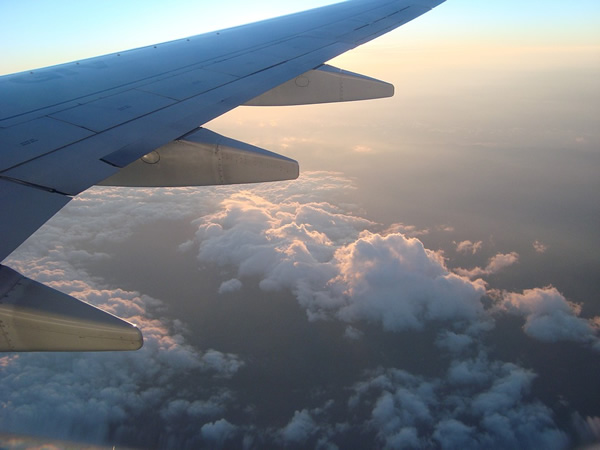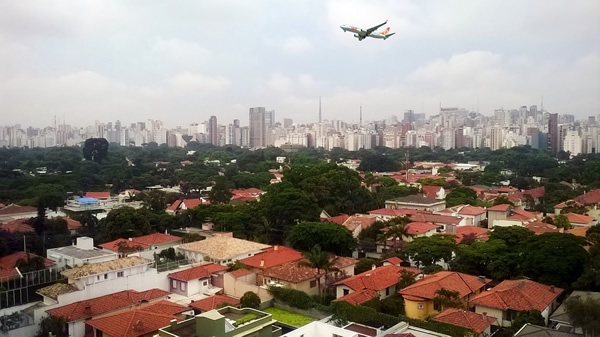Air Travel in South America
Tips for Independent Travelers
By Volker Poelzl
Resources updated 3/1/2024
by Transitions Abroad
 |
|
A window seat view from a plane in Brazil flying over the Amazon.
|
Air travel is necessary to get around quickly on a continent as vast as South America. The Amazon basin, with its myriad rivers and flood plains, and the Andes are formidable obstacles to ground travel, and flying is safer, faster, and more reliable than travel by bus or boat. Flying in South America is also a great way to get an idea of the geography of a country and its vastness. Try to get a window seat and bring your camera for great rainforest and mountain range shots. Small planes on short flights have a lower flight elevation than large jets, and you can enjoy the changing scenery during your flight. It is an unforgettable experience to fly over the Amazon rain forest or the Argentinean Pampas and then watch the landscape rise to form the magnificent Andes, with their snow-capped volcanoes and extensive high plains.
The Cost Factor
When considering buying a plane ticket in South America, it is vital to consider the cost-benefit factor. If you have plenty of time but are on a budget, you might opt for a boat trip on the Amazon instead of flying. A boat trip will cost you half as much but will take several days. If you have little time, it is best to skip long on an uneventful bus or boat ride and fly to your destination. Most countries in South America have their international airline(s) with domestic and international flights to Europe and North America, allowing you to connect to domestic destinations easily.
The Cost of Flying Into South America Versus Within the Countries
The cost of flying into South America from abroad has a long and very complex history, and the factors that go into the price often seem illogical to outsiders due to internal airline inefficiencies. Flying into South America was more expensive when the dollar slipped against some South American currencies during recent years. When the Brazilian real was 3:1 to the U.S. dollar a few years ago, long-haul flights inside Brazil were affordable. Today, with the real exchange rate closer to 5:1, flights would be less expensive for Americans flying into the country from North America. However, inefficiencies in scheduling time (flights are usually overnight and idle at airports for long periods) often push the prices back up when flying into Brazil and other locations in South America, regardless of favorable exchange rates. On the flip side, South America's largest country, Brazil, has deregulated its airline industry over the past decade, and several low-cost carriers now connect many cities across Brazil and South America, resulting in lower costs. However, for incoming international flights, for example, flying into the country can be costly due to the scarcity of flights to Buenos Aires, its long history of inflation problems, and its inefficiencies in scheduling. In other words, inefficiencies are a fundamental cost determinant, so it is best to shop around for airlines that have figured out their scheduling for international flights from North America. There are often considerable disparities in flying into countries from North America than within the larger South American countries themselves. We will discuss cheaper flights within the more prominent countries below.
Remember that international flights in South America are more expensive than domestic flights covering the same distance. Consider a travel plan where you visit natural or cultural attractions that border several countries. In that case, it is best to fly to one country and then continue across the border by bus (or boat). Such is the case with Patagonia, which Chile and Argentina share, the Iguaçu waterfalls (Argentina, Brazil), the Jesuit missions (Argentina, Paraguay, Uruguay, Brazil), the Pantanal wetlands (Brazil, Bolivia, Paraguay), the upper Amazon river (Peru, Colombia, Brazil), and the Andean high-altitude steppes (Argentina, Bolivia, Chile), to mention the most popular.
Transportation Safety Considerations
Traveling up or down the Andes in Ecuador, Peru, and Bolivia by bus can be dangerous, and flying is definitely safer. These dirt roads lead from the Amazon basin (average elevation of 400 feet) up to 10,000 to 15,000 feet and are frequented mainly by cargo trucks. Avoid bus travel in the Amazon basin during the rainy season (October through April south of the equator), when dirt roads turn into mud. Flying is your best option during this time.
If you plan to visit nature parks and reserves in the Amazon, be wise and book a flight. Flights are cheap enough to make them a reasonable alternative to the long and precarious bus rides up or down the Andes. Most rainforest tours and excursions start from cities or towns with developed airports and paved runways connected by conventional commercial flights. On the other hand, if you are adventurous, be aware that many flights to remote areas will land at very primitive airports, often consisting of small clearings in the jungle with a dirt runway.
In some South American countries, government airlines or the Air Force provide cheap flights to remote locations, primarily transporting locals and their cargo. However, they are also open to foreigners. Such flights serve the simple purpose of providing transportation for the locals and do not follow international guidelines for passenger travel. Standing room is standard, and don't be surprised to climb onto a Russian cargo plane through the ramp in the back, put your bags in the center of the fuselage, and then sit on a wooden bench alongside the cabin. You might be traveling with chickens, pigs, and bunches of bananas. Forget about air conditioning and soundproofing. These flights are cheap, but not very comfortable. Fortunately, they are usually relatively short. However, except for Air Force flights, all other passenger air travel in South America is carried out by regular commercial airlines that are up to international standards. Flights are more or less on time, and the airplanes have a reasonable amount of staff. You won't have to carry your baggage aboard the plane and will likely have an assigned seat.
 |
|
A plane ready to land near the center of Sao Paulo, Brazil, an interesting airport location.
|
Booking a Flight
Most airlines in South America have English-language versions of their websites where you can book flights ahead of time. Air Force flights do not offer advanced bookings, and flights fill up on a first-come, first-served basis. To book a flight locally, contact a travel agency or airline office. You may have to ask for a booking agency in remote locations or small towns. It could be a restaurant or government office that doubles as a ticketing agency. If you travel with the Air Force in Peru or Bolivia, expect different timetables. The planes fly their daily routes with little regard for schedules. Get to the airport early and bring something to read while you wait. It is more important for the locals to know that the plane will arrive on a given day, not the exact time. Be prepared to pay for your ticket in cash.
Flight Availability
Air travel is expensive for most South Americans, and fewer people fly than in North America and Europe. As a result, there are fewer flights than you might be used to, often only one per day. You should also expect numerous stopovers before reaching your final destination. Remember that the summer in the Southern Hemisphere (December through March) is the primary travel season and that you should book flights months ahead. Last year in Argentina, I wanted to fly south to visit one of the glacier national parks, but I could not get a seat for another few months. A considerable part of a glacier had broken off a week earlier. Argentineans were flocking to the area to see what was happening. It would have taken three days by bus, and I changed my travel plans. In Bolivia, on another occasion, I tried to book a flight from the Amazon basin to La Paz. Still, I was unaware that it was the weekend of Bolivia's Independence Day celebration, and people had already booked all flights to La Paz. My only option was to take the bus or fly four days later. I decided to take the bus, which I regretted later because the bus had many breakdowns, and the journey took four days instead of two.
Although holidays, festivals, and unexpected natural events can suddenly impact seat availability on flights, it is generally relatively easy in South America to book a flight on short notice without paying a higher fare. Several times, I booked a same-day or next-day flight for a reasonably low price. I have also found that flight dates often change without penalty. Buying a one-way ticket is also quite common, usually costing just half of a round-trip fare, which gives you more flexibility during your travels. Due to the smaller aircraft size, most flights have strict baggage rules. The allowed weight of your baggage varies from airline to airline. Still, you should expect to pay a surcharge for checked baggage over 15 kilos (33 lbs.), but these guidelines vary by airline, so check ahead before you embark on your travels in South America.
Top South American Airlines
LATAM Airlines is a growing South American-based airline — originally Chilean but now has a parent company with Brazilian, Colombian, Peruvian, Argentinean, and Ecuadorian affiliations — offering many cheap domestic and international flights.
GOL is an airline based in Brazil.
Argentinean Airlines is Argentina’s national airline, providing domestic and international flights.
Avianca Airlines is based in Colombia but handles flights throughout South America and worldwide. |
Volker Poelzl is a Living Abroad Contributing Editor for TransitionsAbroad.com. He has extensively traveled in South America, both by air and on
the ground, most recently in Argentina.
|
